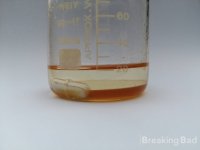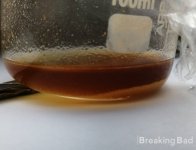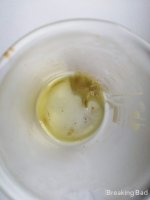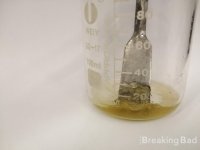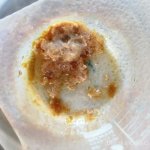G.Patton
Expert
- Joined
- Jul 5, 2021
- Messages
- 2,745
- Solutions
- 3
- Reaction score
- 2,920
- Points
- 113
- Deals
- 1
Introduction

In this topic, you can learn the synthesis of Tramadol (Ultram). This synthetic way presented as two-step path with additional synthesis of 3-lithium anisole precursor in the second one-pot synthesis stage. This method is elementary and don't take a lot of expensive glassware or reagents. Cyclohexanone (1) synthesis from cyclohexanol is represented in the following theme.
Tramadol [2-(dimethylaminomethyl)-1-(3-ethoxyphenyl)cyclohexanol] has two stereogenic centers at the cyclohexane ring. Thus, 2-(dimethylaminomethyl)-1-(3-methoxyphenyl)cyclohexanol may exist in four different configurational forms: The synthetic pathway leads to the racemate (1:1 mixture) of (1R,2R)-isomer and the (1S,2S)-isomer as the main products. Minor amounts of the racemic mixture of the (1R,2S)-isomer and the (1S,2R)-isomer are formed as well. The isolation of the (1R,2R)-isomer and the (1S,2S)-isomer from the diastereomeric minor racemate [(1R,2S)-isomer and (1S,2R)-isomer] is realized by the recrystallization of the hydrochlorides. The drug tramadol is a racemate of the hydrochlorides of the (1R,2R)-(+)- and the (1S,2S)-(−)-enantiomers. The resolution of the racemate [(1R,2R)-(+)-isomer / (1S,2S)-(−)-isomer] was described employing (R)-(−)- or (S)-(+)-mandelic acid. This process does not find industrial application, since tramadol is used as a racemate, despite known different physiological effects of the (1R,2R)- and (1S,2S)-isomers because the racemate showed higher analgesic activity than either enantiomer in animals and in humans.
Tramadol [2-(dimethylaminomethyl)-1-(3-ethoxyphenyl)cyclohexanol] has two stereogenic centers at the cyclohexane ring. Thus, 2-(dimethylaminomethyl)-1-(3-methoxyphenyl)cyclohexanol may exist in four different configurational forms: The synthetic pathway leads to the racemate (1:1 mixture) of (1R,2R)-isomer and the (1S,2S)-isomer as the main products. Minor amounts of the racemic mixture of the (1R,2S)-isomer and the (1S,2R)-isomer are formed as well. The isolation of the (1R,2R)-isomer and the (1S,2S)-isomer from the diastereomeric minor racemate [(1R,2S)-isomer and (1S,2R)-isomer] is realized by the recrystallization of the hydrochlorides. The drug tramadol is a racemate of the hydrochlorides of the (1R,2R)-(+)- and the (1S,2S)-(−)-enantiomers. The resolution of the racemate [(1R,2R)-(+)-isomer / (1S,2S)-(−)-isomer] was described employing (R)-(−)- or (S)-(+)-mandelic acid. This process does not find industrial application, since tramadol is used as a racemate, despite known different physiological effects of the (1R,2R)- and (1S,2S)-isomers because the racemate showed higher analgesic activity than either enantiomer in animals and in humans.
Equipment and glassware:
- 100 mL and 50 mL Round bottom flasks;
- Reflux condenser;
- Rotary evaporator;
- Vacuum source;
- Dewar bath;
- 100 mL x2; 50 mL x2 Beakers;
- 1 L Buchner flask and funnel (or Schott filter);
- Laboratory scale (0.1 — 500 g is suitable);
- 10 mL Drip funnel;
- 100 mL Separating funnel;
- Retort stand and clamp for securing apparatus;
- Nitrogen or Argon balloon 10-20 L (1 atm) is enough;
- Magneticstirrer;
- Glass rod.
Reagents:
- Glacial acetic acid, 20 mL;
- Dimethylamine hydrochloride 0.652 g, 8 mmol;
- Cyclohexanone (1) 1.7 mL, 1.32 g, 16 mmol;
- Paraformaldehyde 0.24 g, 8 mmol;
- Acetone ~100 mL;
- 3-Bromoanisol (3) 0.823 g, 4.4 mmol;
- Tetrahydrofuran (THF) 10 mL;
- n-Butyllithium (n-BuLi) 1.75 M 2.5 mL, 4.4 mmol;
- Dry ice (solid CO2);
- Distilled water, 30 mL;
- Diethyl ether (Et2O) 95 mL;
- Sodium sulfate (NaSO4) or Magnesium sulpfate (MgSO4) 100 g anhydrous;
- Hydrochloric acid (HCl) diethyl ether solution.
Tramadol hydrochloride [(±)-trans-2-[(Dimethylamino)methyl]-1-(m-methoxyphenyl)cyclohexanol hydrochloride]
Boiling Point: 388.1 °C at 760 mm Hg;
Melting Point: 180-181 °C;
Molecular Weight: 299.836 g/mol;
Density: 1.047 g/mL (20 °C);
CAS Number: 36282-47-0.
2–Dimethylaminomethylcyclohexanone hydrochloride (2)
A mixture of glacial acetic acid (20 mL), dimethylamine hydrochloride (0.652 g, 8 mmol), cyclohexanone (1) (1.7 mL, 1.32 g, 16 mmol) and paraformaldehyde (0.24 g, 8 mmol), was refluxed for 3 h in a 100 mL round bottom flask with reflux condenser. The acetic acid and the excess of cyclohexanone were removed in vacuo and the residue was purified by crystallization from acetone and obtained (2) as white crystals (1.16 g, 76 %), mp 154-155 °C.
Tramadol hydrochloride (5)
To a solution of 3-bromoanisol (3) (0.823 g, 4.4 mmol) in dry THF (10 mL), 1.75 M n-BuLi (2.5 mL, 4.4 mmol) was added dropwise at -78 °C (with dry ice in Dewar bath) under inert (argon or nitrogent) atmosphere in 50 mL pear shaped flask.
To a solution of 3-bromoanisol (3) (0.823 g, 4.4 mmol) in dry THF (10 mL), 1.75 M n-BuLi (2.5 mL, 4.4 mmol) was added dropwise at -78 °C (with dry ice in Dewar bath) under inert (argon or nitrogent) atmosphere in 50 mL pear shaped flask.
The mixture was stirred at the same temperature during 45 min and a solution of 2-dimethylaminomethyl-cyclohexanone (2) (0.62 g, 4 mmol free base) in dry THF was added dropwise. The resulting mixture was stirred at -78 °C for 2 h and the solvent was removed in vacuo.
Water (30 mL) was added, and the product was extracted with ethyl ether (3 x 30 mL). The extracts were dried over sodium sulfate, filtered on Buchner flask and evaporated in vacuum. The residue was treated with 5 mL of ethyl ether saturated with hydrogen chloride; the ethyl ether was evaporated in vacuo and the resulting solid was purified by crystallization from acetone. Tramadol hydrochloride (1) was obtained as white crystals (0.94 g, 78.6 %), mp 168-175 °C.
Last edited:

